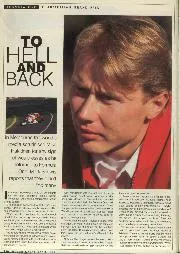The documentary includes a fascinating, rare and extremely awkward joint interview James managed to secure with Schumacher and Hill, thanks to ring master Bernie Ecclestone cracking the whip. Their rivalry was always an odd one. Entirely different as people, we all knew Schumacher was on another planet in terms of pure ability, but Hill had his father’s grit and determination to make the most of the chance he’d landed at Williams – and that likeable mix of a relatively normal, decent, intelligent man facing up to his own self-doubts gave extra meaning to his battles with the greatest driver of this generation.
James had already interviewed Schumacher alone, during which he had punctured the perceptions of the then 26-year-old’s supposed arrogance. When asked what he liked to do in his spare time, Michael rambles a little about taking pleasure from watching the sun rise and set, and looking at the stars. “I found him no more arrogant than William Wordsworth being interviewed about a host of golden daffodils,” quips James.
Together, Michael and Damon sit around a table, their arms folded, looking deeply uncomfortable. Have they ever had a laugh together, asks James? “I think we did, yeah – but I don’t remember it,” says Schumacher. “We’re not best friends. We respect each other, sometimes more than newspapers and television tell.”
They’re both asked what they think of each other, which only increases the toe-curling – James never was one to wilt from asking what few others would. Hill’s answer reminds us that communication channels between these two were always largely limited to what they read about each other in the press – no wonder they never truly understood each other. Schumacher, tellingly, doesn’t really give a straight answer. It’s what they don’t say to James that really offers the most insight into the intensity of their lives at that time.

Hill crosses the line to win the 1995 race and the final one at Adelaide
GREG WOOD/AFP via Getty Images
The grand prix itself turned out to be an odd one, a mix of high attrition and strange end-of-term mistakes. Coulthard took the lead from pole position man Hill, but then ended his Williams career ignominiously, crashing into the pit wall as he came in for a stop; Schumacher tagged Alesi – of all people, given he was about to take his seat – as he attempted to pass after a slow start, ending the race for both; Berger’s Ferrari blew up, as did Herbert’s Benetton; Heinz-Harald Frentzen’s Sauber retired from second place; and Irvine suffered a terminal engine problem with a rare Jordan podium in his sights.
As Hill stroked to an easy win to give him that little glow heading into a winter during which a psychological re-boot would work wonders, Olivier Panis found himself inheriting second place for Ligier – and Gianni Morbidelli scored the only podium of his 67-race F1 career in his Footwork-Hart.
And with that, Adelaide’s F1 history, not to mention a landmark season, was over. On one hand, it feels like yesterday; on the other, it could have been 100 years ago rather than 25.








